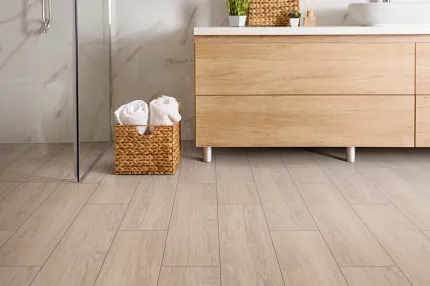TILE AND STONE INSTALLATION
Everything you need to know to ensure your tile and stone is installed properly.
Preparation & Planning
A little research about tile and stone installation will help you understand the process and ensure a smooth and efficient experience.

WHAT TO EXPECT
Scheduling and Timelines
Your retailer may have an in-house installer or may work with you to find an installer for your project. Tile and stone installation is a fairly labor-intensive project, so allow a few days depending on the size of the room.
Room Preparation
Before the installers arrive, you'll need to clear the room of all furniture and belongings. Based on your agreement with your installer, you may be removing any existing flooring, such as old carpet or tile but be sure to discuss this with your installer and ask about pricing.
Subfloor Preparation
Before installation begins, your subfloor will need to meet certain requirements and may need some additional prep work. One of the keys to a successful installation is proper subfloor prep. Your tile and stone will thank you for it!
Protecting Surrounding Areas
Installation of tile and stone can be messy, loud, and dusty so you'll want to ensure that other areas of the house are protected. Sealing air vents, opening some windows, and ensuring other flooring is protected is a good idea.
Choosing a Tile and Stone Installer
Selecting a qualified and experienced tile installer is critical to ensure the job is done right. It is possible to DIY your tile and stone installation but patience and an eye for detail will be needed.
QUESTIONS TO ASK
Experience and Certifications
- How many years of experience do you have installing tile?
- Are you certified by any industry organizations?
Licensing and Insurance
- Are you bonded and insured?
- Can you provide proof of insurance?
Warranty Information
- What warranties do you offer on your workmanship?
References and Portfolio
- Can you provide references from previous clients?
- Do you have a portfolio of your work?
Cost Estimates and Payment Terms
- Can you provide a detailed cost estimate?
- What are your payment terms?

Tile and Stone Installation Process
Here's a high-level overview of the tile and stone installation process:
Removing Old Tile
Many tile installations take place in areas where tile already exists. Old tile will need to be removed and can be a messy process and will require special tools and/or equipment. Be sure to have a conversation with your installer to see if this is included in their price.
Subfloor Preparation
If your subfloor is concrete, the prep may be minimal. Newly poured concrete will always need proper curing time so be sure to discuss this with your installer. Other flooring surfaces will need a backer board for the mortar/adhesive to adhere to and support the distribution of the tile or stone flooring.
Know Before You Begin
Tile and stone installation can be messy and loud so be prepared. Use protection for other flooring in the home to minimize tracking of dust and water. Tile and stone installation may hinge on the weather and temperature so be prepared for weather delays in the event of extreme cold.
Grout Selection
While you may rely heavily on your installer or retailer for most aspects of the installation process, be sure to ask about grout. Choosing the right color of grout is just as important as the selection of the tile. Grout color can completely change the look of your tile so be sure to ask about grout!
Tools for Installation
We've said it before and we'll say it again, tile and stone installation is labor-intensive and requires the use of specialized tools. These tools can be expensive to buy or rent and will require the needed skills to operate. If you decide to install it yourself, be sure to read instructions thoroughly!
The Finishing Touches
NOTE: tile installations are not truly done until a few days after the installer leaves. New tile installations need time to cure and solidify and should not be walked on for at least 48 hours after the tiles are laid. Bathroom or kitchens should remain moisture free for a couple of days so the grout can completely dry.
Tile Installation Information
The downloadable tile installation document found here contains only basic instructions. For detailed instructions refer to American National Standard Specifications (ANSI A1371) for Ceramic Tile, and the Tile Council of North America.
TILE AND STONE INSTALLATION FAQS
Porcelain is considerably denser and more impervious than ceramic tile, which means it is more resistant to fluid passing through. Porcelain also has a much lower rate of water absorption, so it's suitable for interiors and exteriors. Porcelain has a greater breaking strength and is fired at extremely high temperatures, becoming 30% harder than natural stone (like granite and marble).
Yes, but indoor areas must be climate-controlled. Extreme cold can affect mortar and grout curing.
Options include sanded, unsanded, and epoxy grout. It depends on the tile spacing, location, and moisture exposure. Small grout lines, less than 1/8 inch, are ideal for rectified tiles. Rectified tiles are perfectly uniform, with precisely defined edges, requiring the least amount of grout. All other cuts of tile, from tumbled to chiseled to punched, contain slight variations in shape and size. This means larger grout lines, 3/16 inch for example, are necessary to achieve a polished look without emphasizing these variations.
Tile flooring is extremely durable, but improper installation, an uneven subfloor, or heavy impacts can cause cracks. Be sure to use proper prep and expansion joints. Always keep an extra box of tiles on in case damage occurs.
RESOURCES
The preparation, planning, and overview steps listed on this page do not cover all carpet installation scenarios. Always refer to the downloadable guidelines for detailed installation information.

